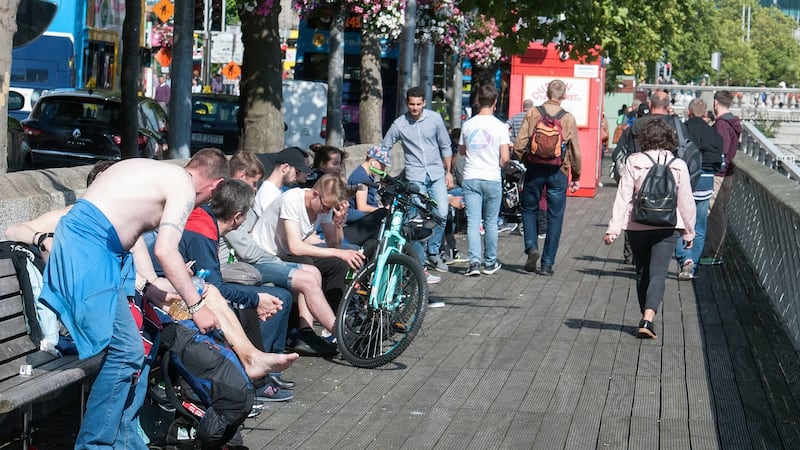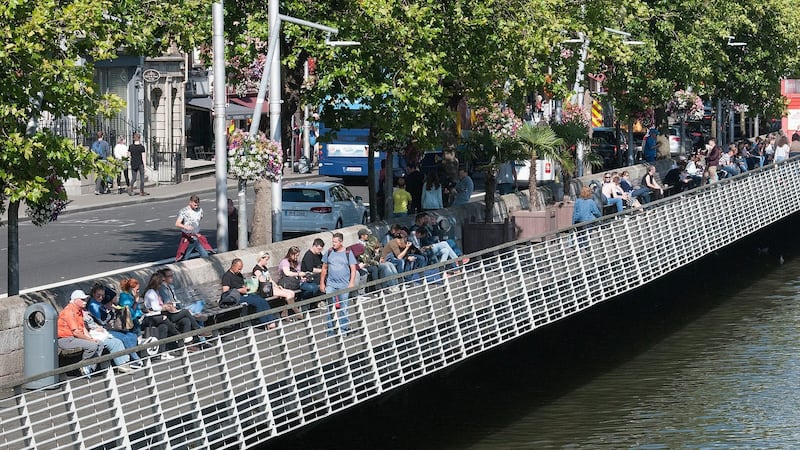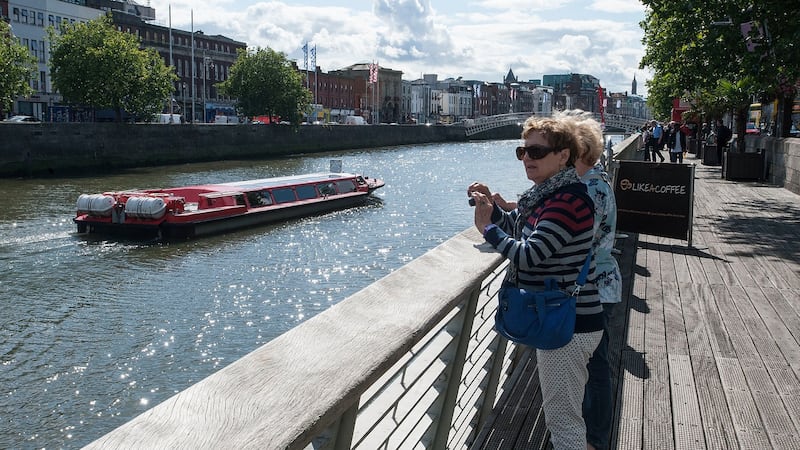“As Dublin changes and expands, it is all the more vital that the very heart of the city would be a place that is visually appealing with a friendly, relaxed atmosphere that all can enjoy.”
These words were spoken by the late Fianna Fáil politician Séamus Brennan on December 17th, 2000, at the official opening of the Liffey boardwalk. At the time, Brennan was the chairman of the National Millennium Committee.
Plans for the £2 million boardwalk were first announced in November 1998, along with a number of other “millennium projects”, by Mile Atha Cliath, a partnership group that had been established to mark the year 2000.
At the 1998 announcement of seven millennium projects, which included the boardwalk, chief executive Dorothy Barry declared that the future structure would be “as nice a recreation space as you could achieve on as narrow a river as the Liffey”.
Any Dubliner who walks along this 'recreation space' will know that the adjective 'nice' is not the first word that usually comes to mind
During the hours that I spent on the boardwalk recently, I observed little of this hopeful city-centre arcadia that Brennan, Barry and many others had envisaged. Any Dubliner who walks along this “recreation space” will know that the adjective “nice” is not the first word that usually comes to mind as a description of the place.
Seventeen years ago, the boardwalk was two-thirds the length it is today. When it first opened, 560 metres of boardwalk ran from O’Connell Bridge up towards Grattan Bridge. An extension was added in March 2005, when a further 224 metres was installed, running between O’Connell Bridge and Butt Bridge. Since then, the Rosie Hackett bridge has been installed, in between these two existing bridges.

Many international cities that have rivers running through them have successfully made their riverbanks public amenities – Boston, London, Paris, Budapest and Prague among them. Before the structure opened, Dublin’s then lord mayor Maurice Ahern declared it would draw the city together by removing the barrier between streets and river. “[The boardwalk] is further evidence that Dublin city can take its place among the chic capitals of Europe.”
In July this year, an 18-year-old female Spanish student met a man on the Liffey boardwalk.
A man has since been charged with falsely imprisoning, raping and threatening to kill the student.
Over several mornings and afternoons since then, I have walked the boardwalk from end to end, spent time sitting on its benches and talking to tourists, locals and regular users of the “amenity”.
I see fellas up to no good, looking at them, watching them. Usually to rob them
“I wasn’t shocked when I heard that story, not at all,” Noel Roche says. Roche walks the boardwalk most days. “I have gone to the rescue of foreign students here quite a few times.”
What does he mean by that? “A lot of tourists, especially the young ones, are very naive. I see fellas up to no good, looking at them, watching them. Usually to rob them. I tell them to be careful. There was seven of them in a row there a week ago, looking over the railings, and taking pictures and all their bags left back at the tables. I could see it all being eyed up.
“The next thing their stuff’d be robbed over the wall and the robbers would be gone off like redshanks [birds]. I whispered to one of them to be careful with their stuff, and she told the next one in Spanish and it went all the way up the line, and they ran back. They thanked me when they were leaving.”
Roche tells me he regularly sees all kinds of anti-social behaviour on the boardwalk. “I’ve seen hoodies and jackets robbed off the back of chairs. Shopping bags. Phones off tables. Then you have fellas pulling up on bikes; they’re the ones with the stuff, delivering to their clients.”
“Stuff?”
“Drugs. Tablets. Phones. The police move people on from time to time, but as soon as the police are gone, the people are straight back. It’s a joke.
“The boardwalk has a very bad name. It’s dangerous. It could explode in a second. I mean, things could kick off in a second, because of all the drinking and everything. That’s what it feels like.”
Asleep on a pool of vomit
The time I spend on the boardwalk is during daylight hours, when the city is busy. Blatant anti-social behaviour is not limited to hours of darkness here. I don’t see a single uniformed garda, but one person points out what he says are three plainclothes guards (a woman and two men), who regularly patrol there.
During the time I sit observing, or walking along the different sections, these are some of the things I see.
€50 notes changing hands for bags of white powder.
A man attempting to jab a needle into his thigh.
Two men fighting and wrestling each other to the ground.
One man kicking another in the head.
One man hitting another with a crutch.
People passed out, both on benches and on the ground.
Men urinating into the Liffey.
A man on a bike delivering a plastic bag of tablets to someone on a bench.
A man asleep on a pool of vomit.
Men and women drinking openly from cans, bottles and flagons.
Drunk people shouting and shoving each other as tourists pass by.
Men openly smoking marijuana.
People begging.
Discarded sleeping bags.
A burned-out rubbish bin.
Sledgehammer attack
The boardwalk was designed by architects McGarry Ni Eanaigh, who still run a practice from an office at Mountjoy Square. Partner of the company, Michael McGarry, explains that, originally, there was pressure to locate it on the south side of the Liffey. “At that time, the river was seen only as a divisive element in the city. We wanted to physically position people in the middle of the city.”
The architects believed the south side of the quays was already well developed, and that locating the boardwalk on the north side would "lure" more pedestrians to that side of the river, which is also the side that receives by far the most direct sunlight.
McGarry explains that the design included three cafes and several market stalls. The market stalls were never built, but the three cafes were. However, "the weekend after they went up, someone attacked one of them with a sledgehammer," McGarry recounts. That third cafe kiosk was taken away, and never replaced.
The architects were not consulted when the Rosie Hackett bridge was installed. “We think the gaps between the boardwalk now are too wide and too disrupting near that bridge,” he said.
There are many tourists . . . who appear not to notice the sub-culture of drug-dealing and drinking going on around them
McGarry acknowledges that anti-social behaviour does regularly take place on the boardwalk. “It is disappointing to us that the boardwalk hasn’t been embraced by the city,” he says. “But it’s a nonsense to say that if we didn’t have the boardwalk, the behaviour would then go away.” He would like to see someone “taking ownership of the boardwalk in a positive way”.
“It’s a shared civic space, and those spaces need to be actively and imaginatively managed, beyond the corpo simply sweeping and cleaning them. The expertise in managing civic realms in Dublin is weak.”
As McGarry says: “In objective terms, it’s a lovely place to sit.”
‘In general, I feel safe’
The boardwalk has a lovely location, with views of the water traffic: the flat red sightseeing boats, groups of kayaks, and a pair of paddleboarders. There are many tourists, particularly on the parts either side of the photogenic Ha’penny Bridge, who appear not to notice the sub-culture of drug-dealing and drinking going on around them.
“This wooden walking place is very nice,” says German tourist Markus Hiersche, who is taking a photograph of his sister Bianca, with the river in the background.
There are also many Dubliners on the benches, sitting out over lunch, or checking their phones.
Mary, who works in an office nearby, does not want to give her surname. She often comes here to eat lunch. “In general, I do feel safe,” she says. “I know there are drug users here, and they get a bit loud sometimes, but I’m used to it.
“I have seen crowds of young people fighting and being obnoxious and knocking each other over, and banging into passersby. That doesn’t create a good impression for the tourists. But the boardwalk gets the sun all day, it’s free, it’s a nice amenity, and where else would these people hang out all day?”
Irishman Mick McGrath and his German partner Jennifer Ley are sitting out together. “I know a few women who won’t come here because they don’t feel safe, even in the daytime,” Ley says. They had seen a drug deal a few minutes previously.
“If there were guards on patrol, it might help. But when they move people on, they just come back,” McGrath says. “Where did all these people sit before the boardwalk was here?”
Mohammed Arif Hossain, from Bangladesh, works at one of the two LikeACoffee booths. The original plans envisaged the presence of cafes, arts and craft stalls and a book market. The only businesses on the boardwalk are the two cafes and a walkway down to the Dublin Discovered Boat Tour.

I go to take a bottle of water from the fridge of cold drinks, but it’s locked. “I have to keep it locked because people steal from it if it’s open,” Hossain explains. He talks to me at intervals in between serving customers, and is unfailingly polite and calm with them all, whether tourists or people whom I’d told are homeless.
“The junkie people take shopping bags from customers and run,” he says. “They have thrown my tables and chairs in the river. They have thrown this [the serviette dispenser] in the river. They steal sunglasses off tables. I have to call the guards, two, three, four times a week.
“Last week, one man broke a chair; he smashed it up on the ground.” Hossain himself has never been personally threatened.
While we’re talking, he keeps looking at the CCTV cameras that are focused on the area on the other side of the wooden kiosk. “A problem is that there is no public toilet here, and people are always trying to use the back of the café for a toilet. There are homeless people sleeping on the benches and then they need to pee.”
‘A policing issue’
The Irish Times asked Dublin City Council to respond to a number of questions about the boardwalk. Asked if they considered it was a successful public amenity, it responded by saying the place was “A new urban space in a riverside city-centre location which has proved popular with tourists and citizens alike. It provides space for walking and resting and this experience has been further enhanced by the recent installation of new LED lighting.”
All other questions, including who is responsible for public safety on the boardwalk, and if the DCC had any plans to address anti-social behaviour on it were answered with a single comment, “It would be more appropriate to talk to the gardaí.”
Whether publicly or privately managed, urban spaces require ongoing resourcing and investment
Ali Grehan, the Dublin City Architect, commented that: “The boardwalk is an extension of Dublin city’s public space network and regrettably, as in other public spaces, is subject to anti-social activity from time to time. This is ultimately a policing issue.
“The physical separation of the boardwalk from activity, business and homes along the quays probably contributes to perceptions about safety.”
She added, “Whether publicly or privately managed, urban spaces require ongoing resourcing and investment.”
‘There is a sense of belonging’
A Dublin Bus driver, who only wants to give his first name, Steve, is on the boardwalk south of O’Connell Bridge, waiting for his shift to start. “I wouldn’t get my phone out around here, unless I have my back to something,” he says. “I see homeless people, druggies, drinkers, here every day. There is only so much walking around the city they can do. There are benches here; somewhere to sit down.”
Someone points out to me a man passed out on a bench. “See the two beside him?” I look at the man and woman alongside him, who are drinking from paper cups. “They’re with him. Nobody will rob his shoes off him now, once they’re there.”
Betty Martins is visiting from the Outer Hebrides to celebrate her 70th birthday. She’s sitting on a bench, taking a rest, and having a careful look at the people who are passing her by.
“I used to be a nurse,” she says. “I worked in wet hostels in London and Glasgow, and I think [the reason] that perhaps Dublin has such a visible problem with drug addicts and alcoholics is that there is nowhere else for them to go.” She saw a drug deal taking place a few minutes before she sat down.
A man who has been homeless for five years, and goes by the name of Jovi, sits down to talk. He breaks off our conversation from time to time to greet passersby by name. “I’d know a lot of people on here,” he says.

“Familiarity to a place is important to a person who doesn’t have anywhere else to go during the day. There is a sort of sense of belonging here for the people who come to the boardwalk.”
Jovi regularly sees dealing going on. “Mostly drugs. Heroin. Crack. Snow blow. Cigarettes. Phones.”
An unpaid debt on a loan can double within as little as an hour
He talks about “double bubble” payments. “If you owe, say €100, and you can’t pay it back by the time they come looking for it, the payment goes up. If it’s twice the original, it’s a double bubble.”
He says an unpaid debt on a loan can double within as little as an hour. “How much you have to pay depends on how vulnerable the person is, who owes the money and how intimidating the person they’re dealing with is.”
When I’ve finished my reporting, I start walking away, down past one of the LikeACoffee kiosks and tables. There is a couple, Italian tourists, sitting with coffees. A wallet is on the table beside them, in full view, and within easy grasping distance. I walk past, and then I go back, to tell them to put the wallet away out of sight.











